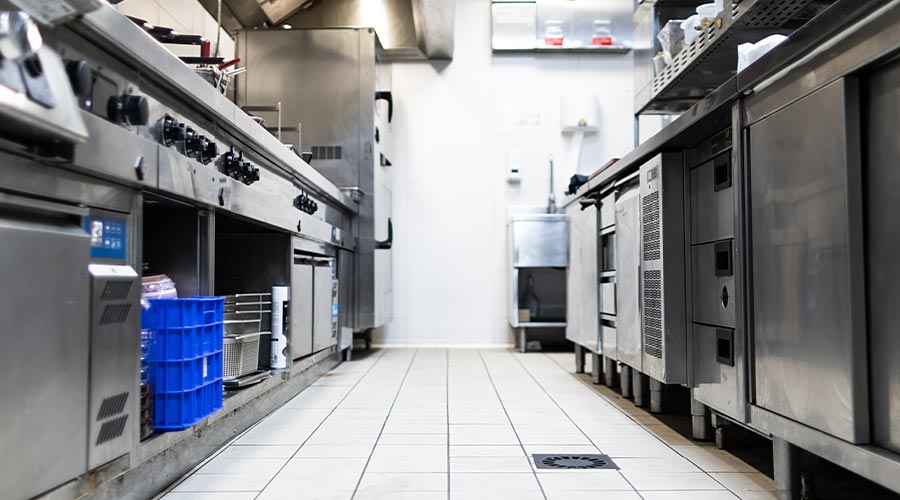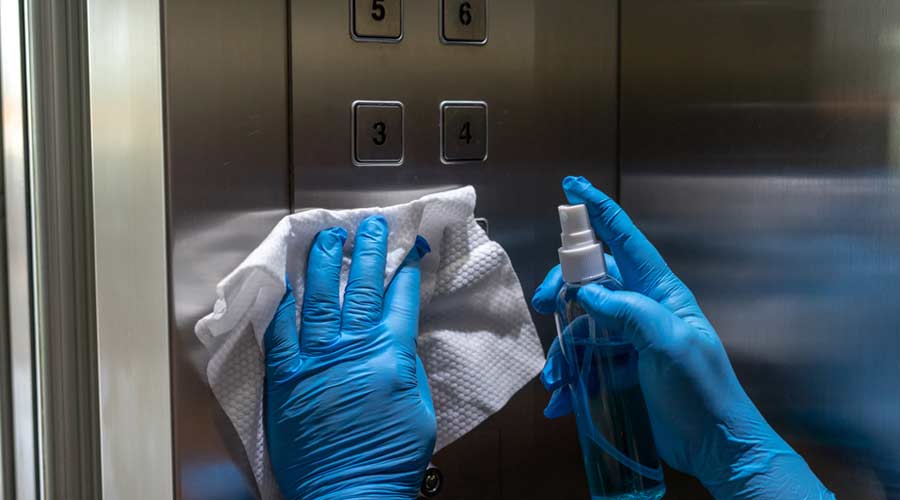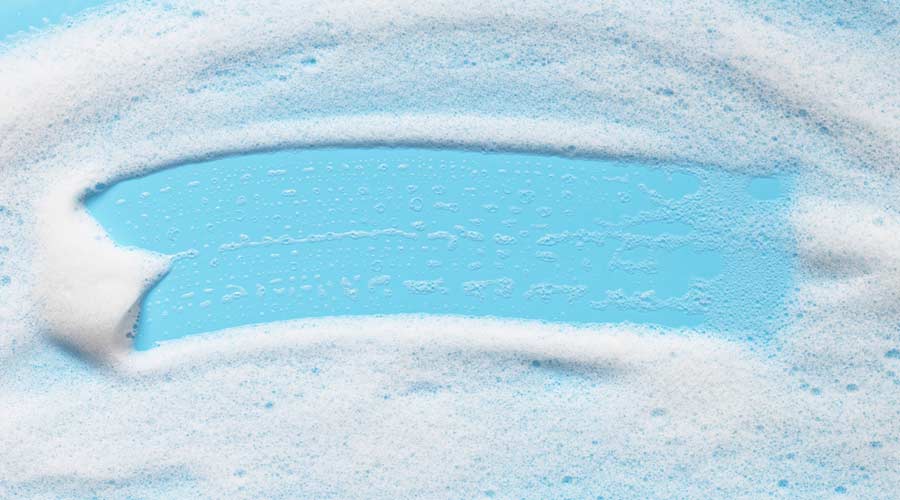
The time, place and method of cleaning affects floor safety and cleanliness. One key concern is the risk of mopping during customer hours. Even with wet floor signs in place, it’s best to limit floor cleaning when guests are present to avoid creating slip hazards in high-traffic areas.
At many restaurants, the standard mop and bucket is still the go-to method for floor cleaning. But this approach can do more harm than good with greasy kitchen floors.
“The worst thing you can do in a restaurant is mop with a bucket, because after the first dip, every subsequent pass just spreads grease around,” Craddock says.
Instead of using a mop and bucket, consider using autoscrubbers on restaurant floors. The machine applies cleaning chemicals, scrubs the floor to break down grease and vacuums up the dirty water.
“You’re always working with clean water and removing the grease, so you get as clean a surface as possible,” says Craddock.
For floors with anti-slip coatings, Craddock recommends adding a specialized cylindrical brush with bristles that scrub deep into a textured surface. This tool dislodges grease and grime embedded in the floor’s aggregate. A deck brush, with a pointed, V-shaped design for tight spaces, can be added to get into edges and corners prone to dirt buildup.
Proper mopping technique is also crucial if mopping is part of the routine. Experts recommend cutting the edges and corners first, using a method that heels the mop into tight spots rather than simply slapping it against walls. Improper mopping can leave behind dirty residue around the perimeter, giving the floor an unsightly, sticky border.
Some restaurants use truck-mounted cleaning systems with high-temperature steam and rotating tools to clean their floors. With these systems, a cleaning tool spins beneath the machine and blasts floors with water heated to nearly 200 degrees. The combination of intense heat and scrubbing liquefies grease while a powerful suction mechanism lifts dirty water away. This tool continuously works with fresh, clean water and is highly effective at removing stubborn buildup.
Chemical Considerations
Chemicals play a key role in facility cleaning, but those used in foodservice environments must not only be safe for guests and staff, but they need to protect surfaces. For this reason, choosing the right chemical isn’t as simple as grabbing a generic degreaser.
In kitchens, degreasers are essential. Whether plant-based, citrus-based or hydrogen-based, these products break down stubborn grease that can create dangerously slick floors. In contrast, dining rooms may require a neutral cleaner that targets other types of soil such as spilled drinks or tracked-in debris. In colder climates, facilities may also need specialized chemicals to remove rock salt residue that standard cleaners can’t dissolve.
Evans says a butyl-based degreaser (also known as butoxyethanol) is an effective option for cutting through heavy, food-related grease. However, he adds, it isn’t the only solution. There are three primary types of solvent-based degreasers: butyl-based, non-butyl-based and d-limonene-based, which is derived from citrus oils. Each formula addresses different grease or oil challenges, and sometimes, a combination product that pulls properties from all three can be the most versatile.
Picking the right solution requires cleaning staff to determine the type of grease they are dealing with. To decide between an alkaline cleaner (high pH) and an acid-based cleaner (low pH), consider whether it’s organic residue, synthetic oils or mineral buildup.
“There is no single product that tackles all grease and oil,” Evans stresses. “Proper diagnosis is key to effective and safe cleaning in foodservice operations.”
Considering the flooring type is also essential. Many commercial kitchens are fitted with quarry tiles with cement or epoxy grout lines. While epoxy is easier to clean due to its non-porous nature, cement grout can absorb soil and grease, making floors appear grimy even after cleaning. For facilities with hard water, chemical deposits or rust stains may also form, requiring an acid-based cleaner.
But caution is critical: “You need to know what kind of flooring you have, because using the wrong chemical, like an acid on a sensitive surface, can cause permanent damage,” Craddock warns.
In addition to selecting the correct product for each area, food safety must remain top of mind. Any cleaner used on or near food-contact surfaces must carry NSF certification, a globally recognized designation that verifies safe products for foodservice settings.
Spills in the kitchen are unavoidable and need immediate attention. Therefore, every food facility should keep a spill kit handy, complete with an absorbent material.
Proper signage is also a simple yet essential part of any floor safety protocol in foodservice environments. Wet floor signs should be prominently displayed in high-risk areas such as entryways on rainy days, self-serve soda stations, restrooms, and anywhere spills are likely.
While floor signs are standard in front-of-house areas, Craddock says they’re often lacking in kitchens, where space is limited and foot traffic is constant. He says that even if there isn’t room for freestanding signs, wall-mounted caution signs can serve as constant visual reminders for staff to tread carefully.
“Creating that awareness can go a long way in reducing accidents and promoting a culture of safety throughout the facility,” he says.
Clean, safe floors are the foundation of a well-run foodservice operation. From grease-tracking and chemical choice to matting placement and signage, every detail plays a role in preventing slips, trips, and falls.
Ronnie Wendt is a freelance writer and owner of In Good Company Communications in Waukesha, Wisconsin. She is a frequent contributor to Facility Cleaning Decisions.
Smart Cleaning is Key for Commercial Kitchens

 The Down and Dirty on Cleaning in Virus Season
The Down and Dirty on Cleaning in Virus Season How Surfactant Use is Expanding in Commercial Cleaning
How Surfactant Use is Expanding in Commercial Cleaning